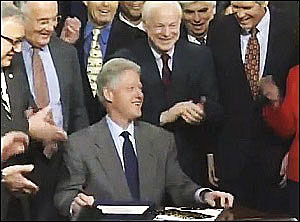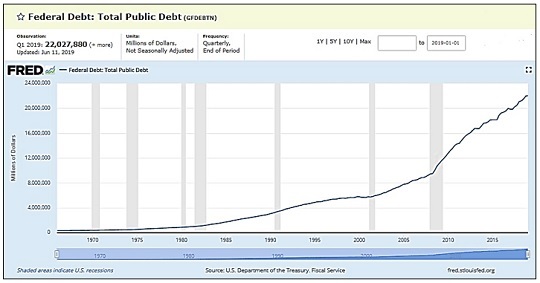By Pam Martens and Russ Martens: August 29, 2019 ~
Yesterday, the Dow Jones Industrial Average closed up 258 points but the yield on the 10-Year U.S. Treasury fell below 1.50 percent. In a normal market, if stocks are rallying that means there is confidence in the trajectory of economic growth in the U.S. When yields are collapsing on U.S. Treasuries, that means there is no confidence of sustained growth in the economy. So you can see why yesterday’s market activity is a serious contradiction of norms.
We believe the Treasury market is already discounting (looking ahead and factoring in) what the next recession is going to look like because of constraints on how much fiscal spending the Federal government can deploy.
To understand just how unprecedented the current amount of national debt is, one has to have some historical figures. At the beginning of the Bill Clinton Presidency in January 1993, the U.S. national debt stood at $4 trillion. At that point, the United States was more than two centuries old; it had financed the Revolutionary War, the Civil War, World Wars I and II and the Vietnam War. The country had also been through the greatest economic collapse in its history, the Great Depression, which required a multitude of fiscal spending programs.
It took more than two centuries for the U.S. national debt to reach $4 trillion but in just the past 26 years, the national debt has grown by $18.5 trillion for a total of $22.5 trillion today. In just the past two and a half years since President Donald Trump took office, the national debt has grown by $2.5 trillion.
One would think that if the national debt is skyrocketing at least some of that largesse might be trickling down to the average folks. Instead, the national debt has been on the same trajectory as income and wealth inequality in the United States – both have reached unprecedented levels.

President Bill Clinton Laughs It Up as He Signs the Repeal of the Glass-Steagall Act, November 12, 1999
The country has the Wall Street-friendly Bill Clinton administration to thank for this mess. He created the heads-we-win, tails-you-lose financial system that has allowed Wall Street to fleece Main Street with impunity since November 12, 1999 – the day that Clinton signed the Gramm-Leach-Bliley Act which repealed the Glass-Steagall Act.
Clinton released a statement on the signing of the Gramm-Leach-Bliley Act which said that the legislation would stimulate “greater innovation and competition in the financial services industry.” Today, just five Wall Street banks control the majority of assets and deposits out of the more than 5,000 banks and savings associations that exist in the U.S. today. The same Wall Street banks are allowed to charge upwards of 20 percent or more on consumer credit cards while paying 2 percent or less to their depositors. Simply put, Clinton inked the contract on a massive wealth transfer system in America. (See also how Wall Street is looting two-thirds of your retirement account.)
Clinton also said this on the occasion of the signing of the legislation:
“The Gramm-Leach-Bliley Act makes the most important legislative changes to the structure of the U.S. financial system since the 1930s. Financial services firms will be authorized to conduct a wide range of financial activities, allowing them freedom to innovate in the new economy. The Act repeals provisions of the Glass-Steagall Act that, since the Great Depression, have restricted affiliations between banks and securities firms. It also amends the Bank Holding Company Act to remove restrictions on affiliations between banks and insurance companies. It grants banks significant new authority to conduct most newly authorized activities through financial subsidiaries. Removal of barriers to competition will enhance the stability of our financial services system.”
The Glass-Steagall Act had kept the U.S. financial system safe for 66 years. It took just nine years after its repeal by Clinton for Wall Street to enrich its own pockets to the tune of billions of dollars, blow up the U.S. economy, and then collect an astounding and secret $29 trillion in below-market-rate loans from the Federal Reserve to bail itself out. Even the insolvent Citigroup was resuscitated with $2.5 trillion in secret, cumulative loans from the Fed, even though the Fed is not allowed to provide loans to insolvent institutions.
By allowing Wall Street to attract money by offering federally-insured deposits and then use those deposits to make trading gambles for the house – which pay off in the form of obscene compensation to the minions on Wall Street – the Gramm-Leach-Bliley Act effectively set the wealth inequality train wreck in motion in the United States.
The late MIT economist, Lester Thurow, explained some three decades ago what happens when wealth is concentrated in too few hands:
“Depression is seen as a product of systematic tendencies for the distribution of wealth to become concentrated among a few. When this happens, demand eventually sags relative to supply and long cyclical downturns commence…
“Essentially, the economic problem is like that of the wolf and the caribou. If the wolves eat all the caribou, the wolves also vanish. Conversely, if the wolves vanish, the caribou for a time multiply but eventually their numbers become too great and they die for lack of food. Producers need consumers, and if producers deprive workers of their fair share of production income they essentially deprive themselves of the affluent consumers they need to make their facilities profitable….”
All of this makes the 2020 Presidential election a critical moment in time for the nation. Electing a person who lacks the in-depth knowledge of how Wall Street and the repeal of the Glass-Steagall Act have created a permanent, inescapable plutocracy in America would be the final death knell for the country.


